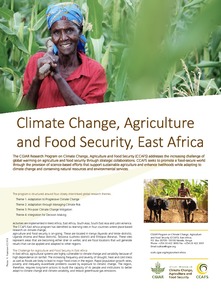Climate adaptation and agriculture: Solutions to successful national adaptation plans
The purpose of this brief is to share insights on agriculture and NAPs with national-level decision makers in developing countries and Least Developed Countries (LDCs), multilateral agencies, UNFCCC negotiators and donors. This brief explores how countries are overcoming the biggest challenges in developing NAPs, outlines examples of successful cross-sector adaptation planning, explores influence and leverage necessary for successful NAP processes, and offers specific recommendations.
Climate change, agriculture and food security: a comparative review of global modelling approaches
The dual relationship existing between land-based activities and climate change has long been established. Land-based activities are responsible for about 30% (IPCC) of global GHG emissions and are at the same time particularly impacted by climate change as they are strongly dependent on weather patterns. Although physical and technical considerations may help to investigate these two kinds of issues, economic considerations are crucial to understand how agricultural producers react to climate change and to climate policies.
Climate change adaptation and mitigation initiatives for agriculture in East Africa
National governments across East Africa are in the process of formulating and implementing adaptation and mitigation strategies to assist farmers cope with climate change. These include formulating actions, frameworks and programs to address climate change and embedding these within the long-term national development plans.
Climate change, agriculture and food security: a strategy for change
Agriculture – on which we all depend for our food – is under threat from climate change. There is no doubt that systems worldwide will have to adapt, but while consumers may barely notice in developed countries, millions of people in developing countries face a very real and direct threat to their food security and livelihoods. Even without climate change, many agricultural systems in developing countries are nearing crisis point. Feeding a rapidly rising global population is taking a heavy toll on farmlands, rangelands, fisheries and forests. Water is becoming scarce in many regions.
Climate change adaptation in agriculture: practices and technologies. Opportunities for climate action in agricultural systems
In this info note we provide a brief overview of key
agricultural practices and technologies which enhance
productivity in a sustainable manner, thus contributing to
food security and environmental goals while increasing
the resilience of farming systems.
A twinned info note considers
higher-level measures of
adaptation in agriculture, such
as policies and institutions. Updated: November 2016.
Both info notes are drawn from
longer working papers, all
freely available to download at
Climate change, agriculture, food security, East Africa
In East Africa, agricultural systems are highly vulnerable to climate change and variability because of high dependence on rainfall. The increasing frequency and severity of drought, heat and cold stress as well as floods are likely to lead to major food crises in the region. Rapid population growth rates, poverty and inequality exacerbate problems caused by exposure to climatic change. The region, therefore, requires long-term actions to build the capacity of its people and institutions to better adapt to climate change and climate variability, and reduce greenhouse gas emissions.
Climate change adaptation in mixed crop?livestock systems in developing countries
Mixed crop?livestock systems produce most of the world’s milk and ruminant meat, and are
particularly important for the livelihoods and food security of poor people in developing
countries. These systems will bear the brunt of helping to satisfy the burgeoning demand
for food from increasing populations, particularly in sub?Saharan Africa and South Asia,
where rural poverty and hunger are already concentrated. The potential impacts of changes
in climate and climate variability on these mixed systems are not that well understood,
Climate change, policy change: Five policy lessons to support women farmers in a changing climate
Climate change demands new approaches to agriculture: farmers’ practices will need to change to adapt to and mitigate the effects of changing conditions. Addressing gender inequality is key to ensuring this outcome. Agriculture is a fundamental part of women’s livelihoods globally, most markedly in least developed countries, where four-fifths of economically active women report agriculture as their primary economic activity1 . More women are moving into agriculture as men move elsewhere for seasonal or paid labor.
Climate change impacts and mitigation in the developing world: an integrated assessment of the agriculture and forestry sectors
This paper conducts an integrated assessment of climate change impacts and climate mitigation on agricultural commodity markets and food availability in low- and middle-income countries. The analysis uses the partial equilibrium model GLOBIOM to generate scenarios to 2080. The findings show that climate change effects on the agricultural sector will increase progressively over the century. By 2030, the impact of climate change on food consumption is moderate but already twice as large in a world with high inequalities than in a more equal world.
Climate Related Risks and Opportunities for Agricultural Adaptation in Semi-Arid Eastern Kenya.
This report contains information on a field assessment of risks associated with climate variability in eastern Kenya. It also includes the compilations of climate related agricultural risks gathered from a Kamba radio dialogue with local communities of Eastern Kenya, aired from January to April 2012. It highlights the significant potential in the region for mitigating climate change through improved management of agricultural land and crop and livestock husbandry practices, as well as on tapping into the wide range of traditional knowledge of the local communities.
Climate Smart Agriculture in the African Context
Agriculture remains vital to the economy of most African countries and its development
has significant implications for food security and poverty reduction in the region. Increase
in agricultural production over the past decades has mainly been due to land area expansion,
with very little change in production techniques and limited improvement in yields.
Currently one in four people remains malnourished in Africa. CSA integrates all three dimensions of sustainable development and is aimed at (1)












